You are reading the older HTML site
Positive Feedback ISSUE 9
october/november 2003
wavac
HE-833 amplifiers - The King of SET!
as reviewed by David Robinson
(All photographs by David W. Robinson and Dave Glackin; all image processing by
Robinson.)
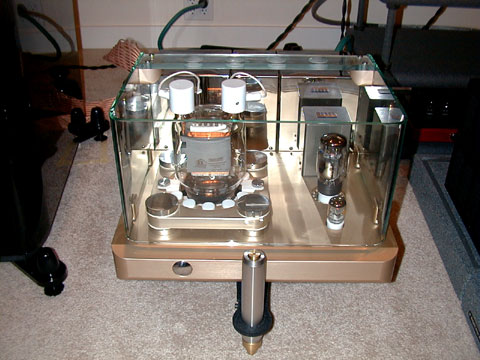
The WAVAC HE-833 100 Watt monoblock on a Sistrum SP-1
Stand: Beauty
and The Beast!
DAVID ROBINSON'S SYSTEM LOUDSPEAKERS ELECTRONICS SOURCES CABLES ACCESSORIES
|
"Sherman, set the Way-Back Machine for 2000… "
Those of our readers who have been following Positive Feedback for a while may remember the long-term, extensive project that I did on Single-Ended Triode (SET) amplification and SACD back in Vol. 8, No. 4, Spring, 2000. (By the way, if you missed that issue, you'll find the text—minus the photographs that the hard copy had—in our PF archives) This was one of the most ambitious reviews that I've ever taken, and concentrated on a series of excellent low-powered SETs, their synergy with the Lowther PM-3A high-efficiency point-source loudspeaker system, and how they handled the early days of SACD playback via a broken-in, but unmodified Sony SCD-1.
I really had an interesting time with that project, and learned a number of things about the virtues of low-powered SETs. For example, they display an excellent sense of life and presence, have great detail without fatiguing the listener, and possess that magical sense of "air" which is so hard to attain in fine audio. Due to their limited power output, however, and the trickiness of getting the trannies and tubes just so, I also came to understand how critical system matching is in such systems. None of the systems ever seemed to have difficulty with SACD playback—instead, as is the case with great turntable playback, SACDs really sounded exceptional on SETs, even if only through a couple of Watts of 2A3.
I also learned about some of the limitations of the flea-powered kit, of course. As I've made clear on a number of occasions, my strong preference is for full-range audio reproduction. Wide macrodynamics, delicate microdynamics, extended frequency range (especially for my SACDs and LPs… I like getting below 20 Hz, and as close to 100kHz as possible, thank you very much!), and properly intonated, timbrally accurate recorded music is just the thing for me. It's important that you realize my preferences here, so that you can take my comments in the context of my sensibilities. Whether you agree with them or not, at least you're aware of them, eh?
There are proponents of lower powered SET systems who will point out, correctly, that with very careful design, proper execution, and rigorous component matching—especially between multiple amps and their associated very high efficiency drivers/enclosures (the "no-holds-barred horns of which can occupy a sizeable chunk of your house and basement!)—even the flea-powered gear can provide astonishing results. I haven't gotten a chance to hear such a system, though my good friend Winston Ma has mentioned that he is experimenting with this option in his grand listening room, a space that is the finest that I've ever heard for fine audio. Now that would be worth hearing!
Anyway, while I enjoyed the blessings of low-powered SETs, ultimately, I reverted to my customary higher powered systems in either push-pull or solid-state configurations. Not that this was my only experience with SETs, mind you; I've had everything from 845's (single and dual tube at 30 to 80 Watts per channel…including the very righteous deHavilland Aries 845 monoblocks, the best of the bunch to these ears!) to 300B's to the mighty Ongaku 211-based amplification in my listening rooms over the years; each was its own special flavor (especially that Ongaku!) None of them was sufficiently compelling for me to foreswear full-range in favor of SET, and the Ongaku was just too bloody expensive to even think about it.
The Past Year
2001-2002 saw me back in the solid-state groove again, as I spent some extended time with Linn's superb Klimax monoblocks with the Nova Rendition II speakers, then paired them up with the Linn Komri reference loudspeakers. Definitely high current, that!
Over the last twelve months, I've had a chance to go a different audio direction, heading back into tube territory. This time I shifted the power point to 100 Watts per channel, and concentrated on various topologies of tubed amplification. First in was audiobud EveAnna Manley's kicking Manley Labs Snapper monoblocks, 100 WPC of EL-34 ultralinear push-pull excellence and technical sweetness. (See PFO Issue 5 for the action!)

The Manley Labs Snapper monoblock amplifier
After that project was completed, good friend Jud Barber, one of the great gentlemen of fine audio, kindly sent along his 100 WPC 6C33-CB-based OTL monoblocks, the Joule Electra VZN-100 Marquis Mk. III's. Instead of nicely done push-pull with very innovative transformers, we had output-transformerless (OTL). A truly wonderful amplifier, described in my PFO review in Issue 6.
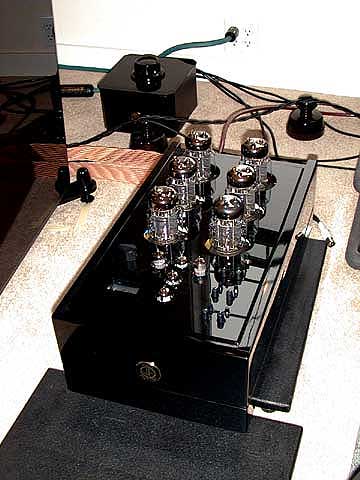
Truly fine OTL monoblocks: The Joule Electra VZN-100 Marquis Mk. III amplifier
Enter the third alternative…
These two 100 WPC topologies were followed by something really different.
All the way back in the later ‘90s, our very own Harvey Rosenberg, AKA "Gizmo," had alerted me to the fine work of Nobu Shisido at WAVAC. We checked into it, and ended up running a cover on WAVAC all the way back in Positive Feedback, Vol. 6, No. 3. (See the PFO archives and click on that issue.) Nobu became an audio friend at a Pacific arms breadth; I could count on a bottle of special nihonshu (sake) every year at Christmas from dear Nobu-san. One of the WAVAC models that Gizmo was very impressed with was the HE-833. He wrote an enthusiastic review on it in the very late ‘90s, one that stuck in my mind. I knew that it was a very special SET amplifier, one that was different than others for a reason of interest to me.
It was an SET with horsepower.
Unfortunately, Nobu Shisido passed away, and I lost contact with the line. So the idea of an HE-833 review rested in the back of my mind together with all sorts of other notions—many of which don't get done, for one reason or another…either life, or logistics getting in the way.
Then, while I was at CES 2001, I crossed paths with Jim Ricketts, the owner of tmh audio. As I recall, Jim and I first "met" over at Audio Asylum's Hi-Rez Highway. He had followed my enthusiasm over SACD and the Sony SCD-1 in the pages of Positive Feedback, and had become quite taken with the quality and possibilities of the format. We stayed in touch with each other, and made arrangements to see each other at the tmh audio room. I brought along some two dozen SACD reference discs, so that he and I could give them a listen on his SCD-1, piped through WAVAC amplification and a pair of Köchel high efficiency speakers, as I recall. Yummy sound for sure!
Another person sat in during these sessions—none other than mastering engineer extraordinaire, Steve Hoffman. Steve was bushed, and looking like he could use something fine—which is precisely happened when we fired up some really good SACDs over the WAVAC.
"Wow! That's music!" said Steve, who ought to know.
We ended up spending several hours listening, while Steve got ever more enthusiastic about SACD. The upshot was that Steve ended up with a promise from Jim to provide WAVAC SET gear to use for mastering a whole series of bloody stellar SACDs for Audio Fidelity. (Which, by the way, if you happen to have been living on Mars and missed any of these SACDs, you should immediately go out and purchase. Want to hear master tape? Listen to Steve's work, amigo!)
I didn't follow the particulars of Jim and Steve's negotiations—I was probably too engrossed in the music—so didn't find out until later, as Steve's SACDs were released, that they had been mastered using a pair of the WAVAC HE-833's!
That got my attention. Starting in mid-2002, I began to bug Jim about getting a pair of the HE-833's into Positive Feedback Online for review. (Charming, was I… but persistent. Just ask Jim!) I saw that the WAVAC HE-833 would be a perfect addition to the 100 WPC tube topology project. Jim agreed, but wasn't able to comply at that time; we could talk about it at CES 2003 and see what could be done then. That was fine with me; the Manley Labs and Joule Electras were in the pipeline by late summer, and I wouldn't have time for the WAVAC before CES.
At CES 2003, Jim and I saw each other again. Jim wasn't feeling too well, but he was having a good show, and I was very impressed with the sound of his room. I circled back to the tmh audio room several times, and got to meet Ito-san of WAVAC, the senior designer behind much of their work nowadays.
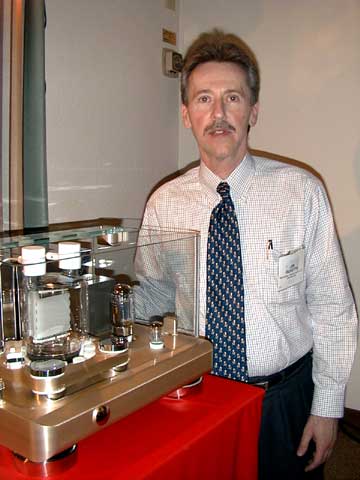
Jim Ricketts of tmh audio at CES 2003; on the left is a WAVAC HE-833 SET monoblock. Gorgeous, no?!
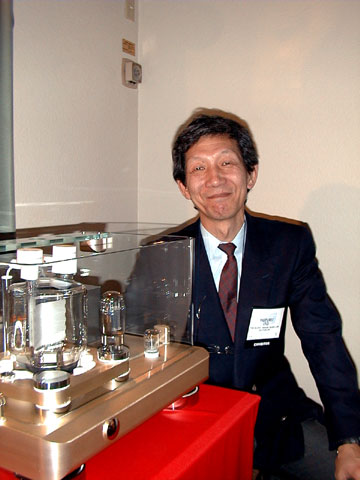
Ito-san of WAVAC Audio in the tmh audio room with the beautiful HE-833 at CES 2003
The upshot of all this was that Jim and I agreed that he would send none other than Steve Hoffman's pair of HE-833's that he had been using to master SACDs at Audio Fidelity. (Talk about "broken in, in a worthy cause"!) I knew that Steve had been raving over the WAVACs, and was delighted that I would be able to experience what Steve had been so impressed with. Furthermore, I was really taken by Steve's mastering in his first batch of SACDs… they are all terrific… so this would be a wonderful opportunity to get to listen to his SACDs on the very amps used to produce them.
This was an almost unheard-of audio possibility.
Was I interested?
You bet!
The arrival…
Within a few weeks after CES, a prodigious set of boxes landed at PFO Central in River City. I gave a call to my good friend Jonathan Tinn of Chambers Audio, who had graciously consented to help me carry (a big deal!) assemble (no big deal) the HE-833's. Warning: these monoblocks are very substantial, and should not be unboxed without a couple of reasonably muscular folks about. Assembly of the amplifiers does require some care, though in the main the instructions are easy to follow. There are special Teflon coated sockets and contacts that have to be handled carefully, but with concentration the assembly is straightforward.
Right off the bat, I would have to say again how gorgeous the HE-833's are. I don't believe that I've ever seen an amplifier that was more stunning to look at in my listening room than these WAVAC are. Folks, I could live with this!
An enthusiastic digression on the Sistrum SP-1 amp stands
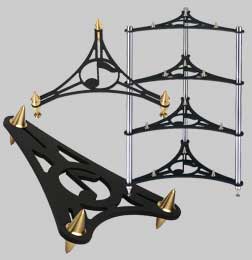
The exceptional Sistrum SP-1 System Stand (left) and SP-6 Rack (not reviewed in this article)
Jim had been kind enough to help me arrange the shipment of a pair of well-matched stands for the HE-833's that he recommended most highly: the Sistrum SP-1 (see below). My interest in good system synergy is no surprise to readers of PF/PFO; I have for many years now been an advocate of looking for good matches in fine audio. Some components do well together in a given room; others do not. (Sorry, Harry—there is no such thing as "absolute sound," nor reference components that are exceptional regardless of their setting.) I therefore usually look for a designer's or a manufacturer's recommended ancillary components, as a point of departure for a review. Oftentimes their recommendation is a good one; sometimes it is not.
This time around, it turned out to be an excellent recommendation.
I had to set up the Sistrum SP-1's before I could proceed with the final placement of the HE-833's. Putting these together was a simple task, though getting the points into the right position for contact with the WAVAC chassis takes some adjustment. Jim Ricketts prefers placing the tiptoes so that the outside of the chassis frame is ‘toed. You'll have to experiment to find a placement that works in your room… I'd agree with Jim.
At the risk of getting ahead of myself, I have to say that the Sistrums certainly have that rare balance of exceptional appearance and functionality. I've used a number of isolation platforms over the years, but the Sistrums are unquestionably among the best that I've ever heard for tube amps. The sound of the HE-833's without the SP-1's is noticeably less clear, less tight and focused; transients just don't have the same "jump" with the HE-833's minus the SP-1's.
The addition of the Sisttrum stands unquestionably improved the performance of the HE-833's—to the point at which I would say that you should not consider the purchase of the WAVAC 833's without also acquiring a pair of the Sistrum SP-1's.
All of my commentary on the HE-833's assume placement on these isolation platforms.
There—SP-1 rave over—enough said!
Technical notes
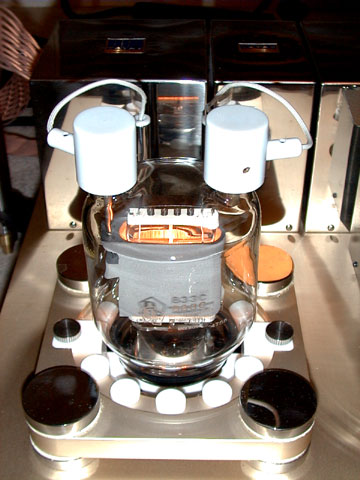
The WAVAC HE-833 is that rare bird: a truly unique amplifier. Built around the potent kick-gluteus maximus triode, the 833A transmission tube, the engineers at WAVAC found a way to drive the 833A in pure Class A mode, using circuit design that they call "IITC" (Inverted Inter-stage Transformer Coupling). As a result, we get to have directly heated triode SET without all the usual compromises in terms of horsepower, and the consequent search for high- or ultra-high efficiency speakers (an audio journey all its own). This frees DH SETs to talk to more demanding speakers (like the Kharma Grande Ceramiques) without having to apologize for the interruption.
The input driver is a single "telecommunications grade" Western Electric 437A, providing extended bandwidth and very low noise. The 437A works in tandem with a single KT-88 driver tube; right now, I am using a pair of Teslas in that role, though Jim kindly provided me with some tube rolling options that I may cover in a follow-up.
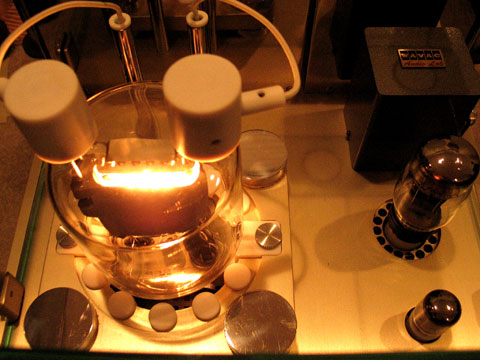
The beauty of the beast in its own light…
(Photograph by Dave Glackin; image processing by Robinson)
(Now stop and think about this, my phine ‘phile phriends: a KT-88 as a DRIVER tube. The mind boggles…) The '88 is wired in triode, and talks to the 833A via a low impedance transformer. WAVAC's audio circuitry is direct-coupled… no capacitors in the signal path… for maximum clarity. The power supply is carefully filtered, and designed to keep hum to a minimum (more on that in a moment). All tube sockets have especially heavy gold plating. The 833 tube has Teflon coated vibration isolating platforms, using what they term "Bete-gel technology; I am not familiar with this system, so can't comment on it… though the results are certainly spectacular. There is a clever thumb screw release for mounting and unmounting the 833 tube without difficulty; the Teflon coated connectors at the top of the 833 attach very easily. (I should note here that WAVAC cautions very strongly against detaching these connectors unless you are sure that the power amps have been fully discharged… at least a couple of hours after powering off, just to be sure. There are lethal voltage here… be careful!)
There is no provision for biasing, so I assume that WAVACs circuitry is auto-biasing—a very pleasant thing.
WAVAC states that the power output for the WAVAC HE-833 is 100 Watts per channel, with a claimed frequency response of 20Hz – 100kHz (!!), though I should note that I didn't see what the +/- dB range for that specification was. Input sensitivity is 1.7Vrms; input impedance is 100k Ohms, with a signal/noise ration of 80dB. Both 4 and 8 Ohm speaker taps are supported. Power consumption is 500 Watts per amp; you'll want to turn these off when you're not listening—no "standby mode"!
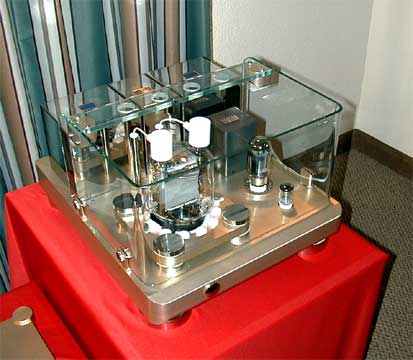
Each chassis measures 435mm wide x 525mm deep x305 high, and weighs in at a bloody hefty 121 pounds (55 kg). This is due to the fact that WAVAC mills these out of solid 60mm "aerospace grade" aluminum blocks. This is much like the stunning work that the folks at Linn do with their exemplary Klimax/CD-12/Kontrol reference series components, with much the same results. The HE-833 is finished in a striking gold, with curb appeal that just doesn't quit, and does NOT pall over time.
A final striking touch to the HE-833 that I'm reviewing is the curving ¼" Pyrex glass canopy that protects the tubes, assists ventilation, and keeps living creatures from getting burned/shocked/killed. It's optional, but I would say that it isn't, really. Don't purchase the HE-833 without these glass covers—they are sine qua non.
Here's a good idea for listening with the HE-833: turn off the lights!
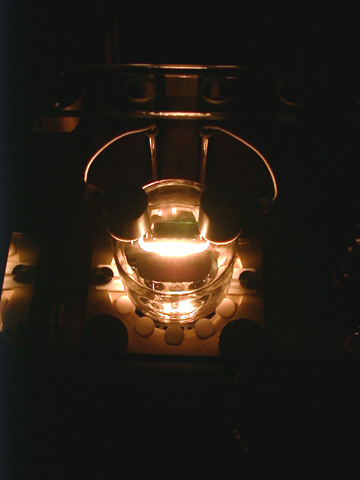
You won't need ‘em, and listening in the glow of these glorious amplifiers is nothing less than heavenly. (Gizmo would advise that you get naked and make love in the light, as well… I leave that to your discretion. Don't get bare skin too close to these tubes, though! You've been warned….)
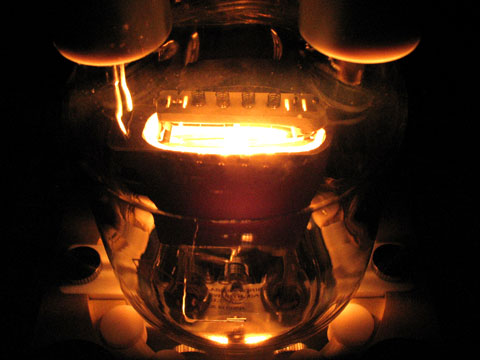
Closer still…
(Photograph by Dave Glackin, image processing by Robinson)
A final very cool point: the WAVAC have output volume controls; given an appropriate source voltage, you should be able to drive these directly, if you prefer.
Some other notes
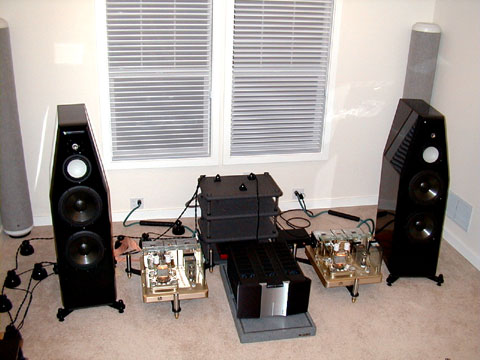
The WAVAC HE-833's being set up on the Sistrum SP-1 platforms, flanked by the spectacular Kharma Grande Ceramique loudspeakers—a truly righteous system under construction!
My listening room, at the top of a hill with lots of great line-of-sight (LOS) for HDTV (excellent!) also has great LOS for radio towers in both the east and west hills of Portland (bogus!). The result was that, WAVAC filtering or not, I had to float the ground of the left channel to get rid of some RFI. Worked fine… but you should know. If you're in an area known for EMI/RFI, you'll want to be prepared to do the usual to deal with the problem. My results were excellent, once dialed in… the HE-833 is vanishingly quiet.
For this extended review, I've used the excellent Kimber Kable Palladium power cords on the WAVAC HE-833's. It's a very fine tandem; the Palladiums are somewhere between the sound of the Cardas Golden (lightly warmish) and the JENA Labs power cables (detailed and revealing). Kimber Kable and this amplifier seem to like each other very well, to these ears.
Shielded JENA Labs unbalanced interconnects were used between the Linn Klimax Kontrol preamp and the WAVAC amps; this also helped to keep RFI out of the way.
Listening impressions
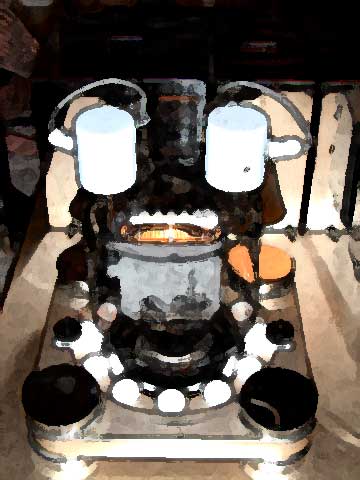
Since Steve Hoffman had done yeoman's work in breaking in this pair of amps, I didn't have to spend too long getting that done, A few days of extended playing, just to get things back to temperature and settled in, then it was off to the races.
I've spent some eight months with the HE-833's as my sole amplification, using it first briefly with the punchy and fun deHavilland UltraVerve reference preamp (yes, I will be writing this super little preamp up soon…hang in there!), then shifting to Linn's brilliant new reference preamp, the Kontrol (sterling, simply sterling!) My main source was the Meitnerized Philips SACD 1000/Meitner DAC-6 for SACDs, with the Linn LP-12 cum their new Akiva reference cartridge, Linn silver reference phono cable, and Lingo power supply via the Manley Labs Steelhead phono amp… all world class music pumps. (The Linn CD-12 came in third, though I have to confess that I don't listen to many CDs any more…the Meitner has made that tough to do, there are a LOT of SACDs out there, and the rest of my listening time is spent with some very toothsome LPs!)
I have spent hundreds of hours listening to the WAVAC, and putting all sorts of music through it. Steve Hoffman's Audio Fidelity SACDs (naturally…and boy do they sound INCREDIBLE through the amps that helped to bring them into the world!) Pentatone classical SACDs, MoFi, FIM, Sony, Telarc, Groovenote, Analog Productions…neither the genre nor the label mattered, I put them all through. A LOT of SACDs… a number of LPs. Friends came over and marveled; audiophiles came by and really got into it.
And I should note one other vitally important point: not once have these amps ever misbehaved or failed in any way whatsoever. Not once. From the time that I assembled them, they have simply worked… eight months of absolute tube reliability under all conditions. And remember, before this these HE-833's had worked with Steve Hoffman at Audio Fidelity for nearly two years! And had then been shipped via surface freight to me, directly from Steve… all this with complete stability, and not a single problem.
Need I say that you can't say this of all tube amps?
Need I point out how bloody impressed I am with this level of superior engineering?
Nah, I don't think I do.
So, after all these months, what do I think of the sound of the WAVAC?
Friends, I've been around a fair number of SETs over the years, as I noted earlier. I've heard a lot of SET-equipped rooms at shows (problematic, mostly), and have listened to SETs in my own room for extended periods of time. I, like many others, have been absolutely smitten by the beauty of single-end triodes: for life, for delicate detail, for living presence, for roundness and glorious unity in the music, they're simply unsurpassed. I have always longed for some magical combination of those qualities with the real authority, dynamics, and full-range playback of higher powered systems… a pairing, if possible, that would truly envelop me in what my good friend Gizmo used to call "musical ecstasy."
I've looked for this for many years—and now I've found it.
There's not a lot of reason to draw this out… no reason to agonize or genuflect.
The WAVAC HE-833 is simply the KING of SETs!
Regardless of the kind of music I was listening to, or its format, the HE-833 never faltered. Its noise floor was incredibly quiet; its handling of detail, getting that roundness right, all were there. "Living presence" was there; "air" was there… triode magic by the bucketful!
AND it had real authority!
No flabby, vanishing bass. No stereotypical "rolled off high frequencies." (100kHz!)
No apologies.
And no prisoners, baby!!
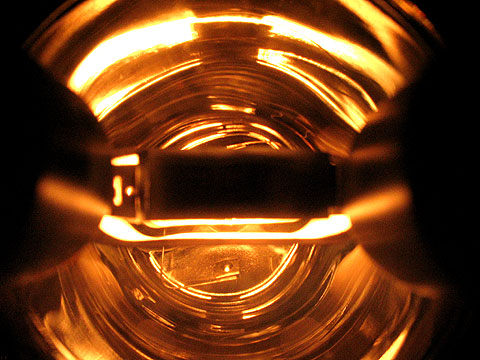
Into the fire…
(Photograph by Dave Glackin, image processing by Robinson)
From the time that I fired them up, the Kharmas jumped to attention, with tight, controlled, extended bass, incredibly dynamics… AND that triode magic of detail and spaciousness that makes a real ‘phile melt. I can't think of a single area of audio reproduction that the HE-833 didn't excel at—not one. In tandem with excellent sources and preamplification, and with the mighty Kharma Grande Ceramiques downstream, there simply wasn't anything that I would fault. It's that fine.
I have just finished listening to a new set of Fantasy jazz recordings on SACD as I finish this review… Monk, Evans, Coltrane… followed by some of the new Bob Dylan hybrid SACDs from Sony… and the glorious sound that the HE-833's made is with me still. I don't have any higher compliment than that: these amps put music into your soul.
The whole thing is really incredible—eight months of experiences like this—and leaves me scratching my head as I search for superlatives that don't sound like an overdose of hyperbole.
I'll put it this way: if I could choose only one amplifier to use for the rest of my life… well, I think the WAVAC HE-833 would have to be it. (Unless it's the HE-833 Model 1.3… see below!)
And, you know, I can hear Gizmo dancing as I type… laughing… saying, "Dude, I told you they were incredible!!!"
You were right, Giz! Where's that body oil…?
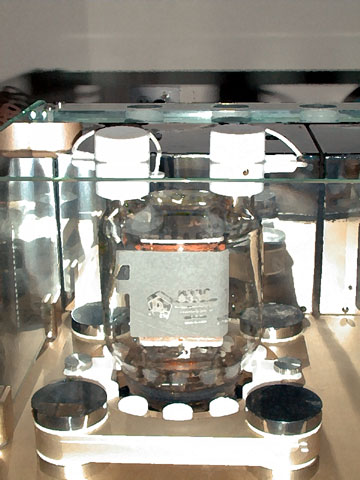
Conclusions
Easy. You can have it all with the WAVAC HE-833.
If you can afford it, this may be all the amplifier that you will ever need, no matter what your taste in music, or what speakers you have.
And don't forget those Sistrum Stands!
Post Scriptum: Oh no! The 833 gets even stronger!
By the way, Jim Ricketts of tmh audio has recently informed me that there is a new, even higher powered version of the HE-833 that has been released by WAVAC: the model 1.3. This ups the ante from the 833 tube all the way up to 150 Watts per channel—a number for SET that boggles the mind!
And I thought I was in trouble before…!
Courtesy of Jim Ricketts and WAVAC, we have arranged a PFO review of this extraordinary new amplifier after CES 2004.
As always, stay tuned….
WAVAC HE-833
Retail: $47,000 per pair
WAVAC importer for the USA
Jim Ricketts, tmh Audio
PO Box 751681
Dayton, OH 45475-1681
TEL: 937. 439. 2667
email address: [email protected]
web address: www.tmhaudio.com
Sistrum Stands
Star Sound Technologies, LLC
1960 Meredith Place
Uhrichsville, Ohio 44683
TEL: 877. 668. 4332
email address: [email protected]
web address: www.audiopoints.com/sistrum.html
David,
A very gracious thank you for a superb review of out "little" 100w/ch
Wavac HE-833 Single-Ended Triode monoamps. Your description of the aesthetic, technical
and sonic attributes was spot-on and the writing style provided a very entertaining read.
It was nice to mention the CES show when I met you and Steve and shared some SACD
moments—definitely good time memories!
A few comments:
All WAVAC amplifiers come with a pyrex glass shield—a nice, aesthetic & functional touch and far more attractive than metal cages.
All WAVAC amplifiers are self-biasing for optimal operation and user friendliness
All WAVAC amplifiers use the IITC circuit with no coupling capacitors in the signal path
All WAVAC amplifiers use only 1 output tube per channel for optimal sonic purity, resolution and magic
I note the use of high quality copper cables in your review—we also have found WAVAC designs work very well with silver cables including silver AC power cables.
tmh audio is very honored to represent WAVAC Audio Lab—it becomes very easy to market as we are so passionate about the WAVAC designs and sonics. Not only the state-of-the-art HE-833 SET, but the more affordable products which also have received rave reviews. These allow more people to experience the WAVAC purity and use the products Steve Hoffman uses in his mastering system.
Again, thanks for the great comments and the professional way the review process was handled.
Best Regards,
Jim Ricketts, tmh audio
US importer of high-performance audio & home theater
products
www.tmhaudio.com
[email protected]
Hello Jim...
Yes, I remember CES 2001 with a great deal of fondness... the main down side to that event was that my digital camera wasn't working properly. No photographs!
Thanks for the clarifications on the WAVAC line. I suspected that your points were true, but without researching the entire line, I wouldn't have been able to say so authoritatively. WAVAC seems to be onto some very special developments; I can see why you're pleased to be distributing their work.
All the best to you and the fine folks at WAVAC...
david
Editor-in-Chief, Positive Feedback Online
[email protected]
